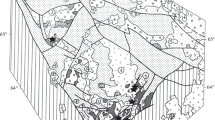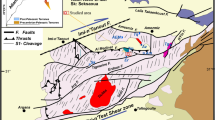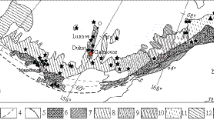Abstract
The Valunistoe Au–Ag deposit is the third largest among epithermal deposits in Chukotka after the Kupol and Dvoinoe. It is located at the western closing of the East Chukotka flank zone of the Okhotsk-Chukotka volcanic belt. Volcanic domes (Pravogornenskaya, Zhil’ninskaya, Shakhskaya, Valunistaya, Shalaya, and Oranzhevaya, each is 3–6 km in diameter) have the main ore-controlling significance in the area; they form a chain elongated to the northeast, along the Kanchalan fault zone. Near the deposit, Upper Cretaceous volcanics are widespread: ignimbrites, lavas and tuffs ranging from rhyolite to basaltic composition, and lenses and interbeds of sedimentary rocks, subvolcanic bodies and dikes of andesites, basalts, and dacites. The structure of the deposit is caused by its localization within the limits of the eponymous (Valunistaya) volcanic dome. Twelve ore-bearing vein zones with thicknesses ranging from several to several tens of meters have been revealed at the deposit. The Glavnaya (Main) and Novaya (New) vein zones have been studied in detail; they are traced along their strikes to a distance of more than 1500 m and consist of en echelon veins 1.0 m thick on average, with lengths varying from 100 to 400 m. Based on the sampling data, Au and Ag contents in ores are 0–474.3 and 0–3794.23 g/t, respectively. Colloform-banded structures are frequently encountered, often combined with breccia structures. The main vein minerals are quartz and adularia; calcite, chlorite, fluorite, sericite, pyrophyllite, kaolinite, montmorillonite, gypsum, and epidote are less frequent. The main ore minerals are pyrite, acanthite, chalcopyrite, galena, sphalerite; secondary ore minerals are native Au and Ag and polybasite; rare ore minerals are pearceite, magnetite, hematite, marcasite, freibergite, tetrahedrite, bournonite, hessite, matildite, and others. Ores are characterized by an Au/Ag ratio from 1 : 5 to 1 : 10 and sulfidity (0.5–5%). Ores are enriched in many elements (Au, Ag, Sb, Cd, Pb, Cu, Zn, As, Se, Mo, Te, and Cr), with enrichment factors ranging from several times (Se, Mo, Te, and Cr), to tenfold (Cd, Pb, Cu, and Zn) and hundredfold (Sb) levels, reaching an excess of tens and hundreds thousand times for Au and Ag (Fig. 7). Ores are characterized by a low total REE and demonstrate positive Eu anomalies. Geochemical features are consistent with the mineral composition of ores. Full homogenization of fluid inclusions in quartz occurs at temperatures of 203–284°C and 174–237°C in calcite, while the salt concentration in both cases is from 0.2 to 0.7 wt % NaCl equiv. Fluid density changes from 0.87 to 0.56 g/cm3. The results give grounds to attribute the Valunistoe deposit to the low-sulfidized epithermal class. The data provided in the article are of practical value for regional forecast–metallogenic maps and can be used in searching for and appraising epithermal Au–Ag deposits.













Similar content being viewed by others
Notes
Hereinafter, “*” after the year of a reference denotes a production report stored in the holdings of Rosgeolfond (Russian Fund for Geology).
REFERENCES
Akinin, V.V. and Miller, E.L., Evolution of calc-alkaline magmas of the Okhotsk–Chukotka volcanic belt, Petrology, 2011, vol. 19, no. 3, pp. 249–290.
Bau, M., Rare–earth element mobility during hydrothermal and metamorphic fluid–rock interaction and the significance of the oxidation state of europium, Chem. Geol., 1991, vol. 93, pp. 219–230.
Belyi, V.F., Geologiya Okhotsko–Chukotskogo vulkanogennogo poyasa (Geology of the Okhotsk–Chukotka Voclanogenic Belt), Magadan: SVKNII DVO RAN, 1994.
Bodnar, R.J. and Vityk, M.O., Interpretation of microthermometric data for H2O–NaCl fluid inclusions, Fluid Inclusions in Minerals: Methods and Applications, Siena: Pontignano, 1994, pp. 117–130.
Bodnar, R.J., Lecumberri–Sanchez, P., Moncada, D., and Steele–Maclnnes, P., Fluid inclusions in hydrothermal ore deposits, Reference Module in Earth Systems and Environmental Sciences, Treatise on Geochemistry, 2nd Ed. (Elsevier, 2014), 119–142.
Borisenko, A.S., Cryometric study of salt composition of gas–liquid inclusions in minerals, Geol. Geofiz., 1977, no. 8, pp. 16–27.
Bortnikov, N.S., Geochemistry and origin of the ore-forming fluids in hydrothermal–magmatic systems in tectonically active zones, Geol. Ore Deposits, 2006, vol. 48, no. 1, pp. 1–22.
Bortnikov, N.S., Gamyanin, G.N., Vikent’eva, O.V., Prokof’ev, V.Yu., Alpatov, V.A., and Bakharev, A.G., Fluid composition and origin in the hydrothermal system of the Nezhdaninsky gold deposit, Sakha (Yakutia), Russia, Geol. Ore Deposits, 2007, vol. 49, no. 2. pp. 87–128.
Brown, P., Flincor: a computer program for the reduction and investigation of fluid inclusion data, Am. Mineral., 1989, vol. 74, pp. 1390–1393.
Bryzgalov, I.A. and Krivitskaya, N.N., Composition of silver minerals of the Ag–Pb–Bi–Te–S system of the Valunistoe deposit, Northeast Russia, Rol’ mineralogii v razvitii mineral’no–syr’evoi bazy blagorodnykh metallov i almazov XXI veka (Role of Mineralogy in the Development of the Raw-Mineral Base of Noble Metals and Diamonds of 21th Century), Moscow: IGEM RAN, 1998, pp. 28–30.
Sidorov, A.A., Belyi, V.F., Volkov, A.V., Alekseev, V.Yu., and Kolova, E.E., The gold–silver Okhotsk–Chukotka volcanic belt, Geol. Ore Deposits, 2009, vol. 51, no. 6, pp. 441–455.
Elmanov, A.A., Prokof’ev, V.Yu., Volkov, A.V., Sidorov, A.A., and Voskresenskii, K.I., First data on formation conditions of the Zhilnoye Au–Ag epithermal gold deposit (Eastern Chukotka, Russia), Dokl. Earth Sci., 2018, vol. 480, no. 6, pp. 725–729.
Goryachev, N.A., Vikent’eva, O.V., Bortnikov, N.S., Prokof’ev, V.Yu., Alpatov, V.A., and Golub, V.V., The world-class Natalka gold deposit, northeast Russia: REE patterns, fluid inclusions, stable oxygen isotopes, and formation conditions of ore, Geol. Ore Deposits, 2008, vol. 50, no. 5, pp. 362–390.
Keithe, T., White, D., and Beeson, M., Hydrothermal alteration and self sealing in Y–7 and Y–8 drillholes in the northern part of Upper Geyser Basin, US Geol. Soc. Prof. Paper, 1978, vol. 1054A, pp. 34–49.
Kryazhev, S.G., Prokof’ev, V.Yu., and Vasyuta, Yu.V., Application of ICP–MS method in analyzing the composition of ore-forming fluids, Vestn. Mosk. Gos. Univ., Ser. 4. Geol., 2006, no. 4, pp. 30–36.
Kun, L., Ruidong, Y., Wenyong, Ch., et al., Trace element and REE geochemistry of the Zhewang gold deposit, southeastern Guizhou province, China, Chin. J. Geochem., 2014, vol. 33, pp. 109–118.
Leier, P.V., Ivanov, V.V., Ratkin, V.V., and Bundtsen, T.K., Epithermal gold–silver deposits of Northeast Russia: the first 40Ar–39Ar age determinations of the ores, Dokl. Earth Sci., 1997, vol. 356, no. 5, pp. 1141–1144.
Manning, D.A.C., Comparison of geochemical indices used for the interpretation of palaeoredox conditions in ancient mudstones, Chem. Geol., 1994, vol. 111, pp. 111–129.
Mineev, D.A., Lantanoidy v rudakh redkozemel’nykh i kompleksnykh mestorozhdenii (Lanthanides in Rare-Earth Ores and Complex Deposits), Moscow: Nauka, 1974.
Monecke, T., Kempe, U., and Gotze, J., Genetic significance of the trace element content in metamorphic and hydrothermal quartz: a reconnaissance study, Earth Planet. Sci. Lett., 2002, vol. 202, nos. 3–4, pp. 709–724.
Newberry, R.J., Layer, P.U., Ganz, P.B., et al., Preliminary analysis of chronology of Mesozoic magmatism and mineralization at Northeast Russia with allowance for 40Ar/39Ar dates and trace element data of igneous and mineralized rocks, Zolotoe orudenenie i granitoidnyi magmatizm Severnoi Patsifiki (Gold Mineralization and Granitoid Magmatism of Northern Pacific), Magadan: SVKNII DVO RAN, 2000, vol. 1, pp. 181–205.
Naboko, S.I. and Glavatskikh, S.F., Hydrothermal minerals of Goryachii Beach, Mineralogiya gidrotermal’nykh sistem Kamchatki (Mineralogy of Hydrothermal Systems of Kamchatka), Moscow: Nauka. 1970.
Novgorodova, M.I., Veretennikov, V.M., Boyarskaya, R.V., et al., Geochemistry of trace elements in quartz, Geokhimiya, 1984, no. 3, pp. 370–383.
Novoselov, K.A., Kotlyarov, V.A., Belogub, E.V., Silver sulfoarsenides from ores of the Valunistoe gold–silver deposit, Chukotka, Zap. Ross. Mineral.O-va, 2009, vol. 138, no. 6, pp. 56–61.
Oreskes, N. and Einaudi, M.T., Origin of rare–earth element enriched hematite breccias at the Olympic Dam Cu–U–Au–Ag deposit, Roxby Downs, South Australia, Econ. Geol., 1990, vol. 85, no. 1, pp. 1–28.
Polin, V.F., Petrologiya kontrastnoi serii Amguemo–Kanchalanskogo vulkanicheskogo polya Chukotki (Petrology of the Bimodal Series of the Amguem–Kanchalansk Volcanic Belt), Vladivostok: DVO AN SSSR, 1990.
Remy, H., Treatise on Inorganic Chemistry (Elsevier, London, 1956), Vol. 1.
Rusinov, V.L., Metasomaticheskie protsessy v vulkanicheskikh tolshchakh (Metasomatic Processes in Volcanic Sequences), Moscow: Nauka, 1989.
Sakhno, V.G., Polin, V.F., Akinin, V.V., Sergeev, S.A., Alenicheva, A.A., Tikhomirov, P.L., and Moll–Stolkap, E. J., The diachronous formation of the Enmyvaam and Amguema–Kanchalan volcanic fields in the Okhotsk–Chukotka Volcanic Belt (NE Russia): evidence from isotopic data, Dokl. Earth Sci., 2010, vol. 434, no. 2, pp. 1172–1178.
Sidorov, A.A., Zoloto–serebryanaya formatsiya Vostochno–Aziatskikh vulkanogennykh poyasov (Gold–Silver Formation of the East Asian Volcanogenic Belts), Magadan, 1978.
Simmons, F.A., White, N.C., and John, D.A., Geological characteristics of epithermal precious and base metal deposits, Econ. Geol., 2005, Vol. 100, pp. 485–522.
Struzhkov, S.F., Province of the Okhotsk–Chukotka volcanogenic belt, Zolotorudnye mestorozhdeniya Rossii (Gold Deposits of Russia), Moscow: Akvarel’, 2010, pp. 213–242.
Taylor, S.R. and McLennan, S.M., The Continental Crust: its Composition and Evolution, Oxford: Blackwell, 1985.
Vinokurov, S.F., Europium anomalies in ore deposits and their geochemical significance, Dokl. Earth Sci., 1996, vol. 346, no. 6, pp. 281–283.
Vinokurov, S.F., Kovalenker, V.A., Safonov, Yu.G., and Kerzin, A.L., REE in quartz from epithermal gold deposits: distribution and genetic implications, Geochem. Int., 1999, vol. 37, no. 2, pp. 145–152.
Volkov, A.V., Goncharov, V.I., and Sidorov, A.A., Mestorozhdeniya zolota i serebra Chukotki (Gold and Silver Deposits of Chukotka), Magadan: SVKNII DVO RAN, 2006.
Volkov, A. V., Prokof’ev, V. Yu., Savva, N. E., Sidorov, A.A., Byankin, M.A., Uyutnov, K.V., and Kolova, E.E., Ore formation at the Kupol epithermal gold–silver deposit in northeastern Russia deduced from fluid inclusion study, Geol. Ore Deposits, 2012, vol. 54, no. 4, pp. 295–303.
Volkov, A.V., Sidorov, A.A., Savva, N.E., Kolova, E.E., Chizhova, I.A., and Murashov, K.Yu., The geochemistry of volcanogenic mineralization in the northwestern segment of the Pacific ore belt: Northeast Russia, J. Volcanol. Seismol., 2017, vol. 11, no. 6, pp. 389–406.
Volkov A.V., Sidorov A.A., Prokof’ev V.Yu., Savva N.E., Kolova E.E., and Murashov K.Yu. Epithermal mineralization in the Okhotsk–Chukchi Volcano-Plutonic Belt, J. Volcanol. Seismol., 2018, vol. 12, no. 6, pp. 359–378.
Zharikov V.A., Gorbachev N.S., Lightfoot, P., and Doherty, W., Rare earth element and yttrium distribution between fluid and basaltic melt at pressures of 1–12 kbar: evidence from experimental data, Dokl. Earth Sci., 1999, vol. 366, no. 2, pp. 543–545.
Funding
The study was supported by the Russian Foundation for Basic Research (project no. 18-05-70001).
Author information
Authors and Affiliations
Corresponding author
Ethics declarations
The authors declare that they have no conflict of interest.
Additional information
Translated by N. Astafiev
Rights and permissions
About this article
Cite this article
Volkov, A.V., Prokof’ev, V.Y., Vinokurov, S.F. et al. Valunistoe Epithermal Au–Ag Deposit (East Chukotka, Russia): Geological Structure, Mineralogical–Geochemical Peculiarities and Mineralization Conditions. Geol. Ore Deposits 62, 97–121 (2020). https://doi.org/10.1134/S1075701520020075
Received:
Revised:
Accepted:
Published:
Issue Date:
DOI: https://doi.org/10.1134/S1075701520020075




